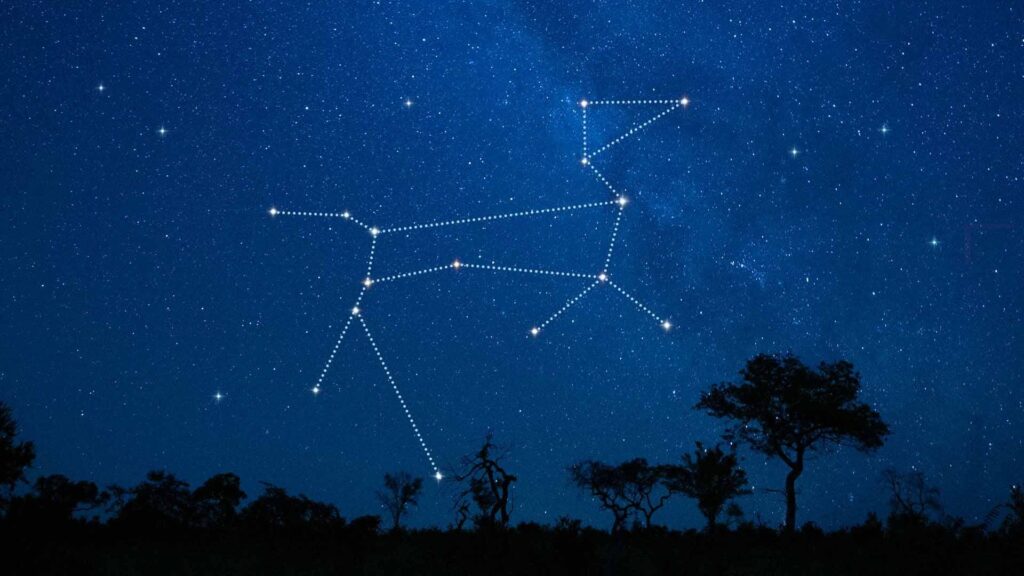Canis Major Dwarf Galaxy is in the Canis Major constellation as you can observe from its name. It is a dwarf-sized galaxy unlike our Milky Way or Andromeda Galaxy. In this article, you will find out the interesting Canis Major Dwarf Galaxy facts and figures. Discovered in 2003, it remained hidden for so long because it lies behind the thick dust of the Milky Way’s disk.
Table of Contents

Interesting Facts about the Canis Major Dwarf Galaxy
1) Canis Major Dwarf Galaxy is the closest galaxy to Earth and the Milky Way. It is approximately 25,000 light-years away from the Sun (or Earth, as the Sun and Earth are only 8 light-minutes apart) and 42,000 light years away from the centre of our Milky Way galaxy.
2) Currently, Canis Major Dwarf galaxy is getting merged with Milky Way galaxy. The immense gravitational power of Milky way is causing this and stretching the galaxy and its stars into streams, known as tidal tails, which is wrapping around our galaxy. It will completely merge with the Milky Way over the next billion years.
3) It has a mass of around a billion Suns. It is much smaller as compared to Milky Way and Andromeda which both have more than 1 trillion solar masses.
4) This dwarf galaxy remained hidden behind the Milky Way’s dust and gas like disk in its outer part. It was discovered in 2003 by an international team of astronomers using the Two-Micron All Sky Survey (2MASS) which enabled them to peer through the dust, uncovering regions that had never been seen before using infrared wavelengths.
5) It is located in the same area of the sky as the constellation Canis Major.


6) Canis Major Dwarf galaxy lies in the Local Group. It is a group of neighbouring galaxies like Andromeda, Milky Way and numerous dwarf galaxies all located within 5 million light years of space. All of the galaxies of Local Group will eventually merge under gravitational pull of each year in tens of billions of years.
7) Canis Major Dwarf galaxy is also called as Canis Major Overdensity. There are scientists who do not consider it a dwarf galaxy but rather a warped section of the galactic disc instead.
8) Its diameter is around 5000 light years long and is an irregular shaped galaxy and not spiral or elliptical.
9) The galaxy contains relatively much higher number of red giant stars. These are the giant stars (way bigger than Sun) nearing the end of their life. Around 1 billion stars are present in it and for reference and comparison, our Milky Way has around 100 to 400 billion stars in it.
10) The Canis Major Dwarf Galaxy was formed in the early stages of the universe’s history. For reference, big bang is estimated to have happened 13.8 billion years ago.
11) The Canis Major Dwarf Galaxy is located at coordinates 07h 12m 35.0s in right ascension (R.A.) and -27° 40′ 0″ in declination (Dec.). Right ascension and declination correspond to the celestial coordinates that are similar to longitude and latitude on Earth.
12) The Canis Major Dwarf Galaxy is situated in the southern hemisphere of the celestial sky, much like the Earth’s southern hemisphere. For reference, the closest star visible to the naked eye near the Canis Major Dwarf Galaxy is Omega Canis Majoris.
13) The brightest and famous star in our sky, Sirius lies under Canis Major Constellation; however, it is located in Milky Way Galaxy.
Quick Facts about the Canis Major Dwarf Galaxy
| Parameter of the Canis Major Dwarf Galaxy | Value |
| Distance from Sun (Earth) | 25,000 light years |
| Discovery | 2003 (using 2MASS) |
| Mass | Around 1 billion Solar Masses |
| Diameter | 5000 light years |
| No of Stars | 100 billion |
| Galaxy Coordinates | 07h 12m 35.0s R.A. and -27° 40′ 0″ Dec. |
| Shape of Galaxy | Irregular |
Conclusion
As it is Milky Way’s nearest satellite galaxy, its gradual absorption into our galaxy helps us in understanding how galaxies evolve and interact and ultimately important for us to know the Canis Major Dwarf galaxy facts. Even though it is partially hidden by the Milky Way’s disk, modern observational techniques have enabled astronomers to explore its features, providing deeper insights into the history of the Milky Way and its neighbouring galaxies.



It’s smart to be cautious with new platforms – security is key! Seeing detailed operational info, like at PH222 login app, does build trust. Seamless onboarding is a huge plus too, avoiding frustrating hurdles. 🤔
Solid article! Thinking about bankroll management is key, especially when exploring new platforms like jiliph – starting small with slots like Fortune seems smart for beginners. Good read!